Page content
- What amount of dangerous substances can I store in the workplace?
- Can I work alone in a room containing dangerous substances?
- Can I disinfect a worktop by spraying alcohol 70% on it?
- Can I store flammable substances in my workplace?
- Can I add water to a concentrate?
- Can I clean with a strong cleaner and then with chlorine?
- Can I mix cleaning products?
- Where can I find information about personal protective equipment?
- Must I wear personal protective equipment when using cleaners?
- Am I obliged to wear Personal Protective Equipment?
- If I wear normal spectacles, do I also need to put on safety goggles?
- Am I obliged to wear PPE when filling smaller containers?
- Can I use the same gloves for all dangerous substances?
- Should there be a warning sign on the door of our lab?
- Can I leave my dangerous substances in the fume cupboard?
- Can I store 1 M NaOH and 1 M HCl next to each other at the pH meter?
- Can I to see whether a fume cupboard is working properly?
- Can I work alone in the lab?
- Can I request an occupational health examination myself?
- Is an occupational health examination always useful?
- Is the entrance door to a lab allowed to be left open?
- Does the limit determine whether working with a substance is hazardous?
- Are dangerous substances allowed to evaporate in the fume cupboard?
- Can I transport liquid nitrogen in a passenger lift?
What amount of dangerous substances can I store in the workplace?
The storage of a working stock in the workplace is permitted, but not in large quantities. Regulations (PGS 15) stipulate a maximum of 25 kg or litres of dangerous substances per room. For flammable liquids under processing or as waste, the limit is set at 1 litre per m2 floor area. If this quantity is exceeded, storage in a ventilated safety cabinet is required. Always use as small a volume as possible for the working stock.
Can I work alone in a room containing dangerous substances?
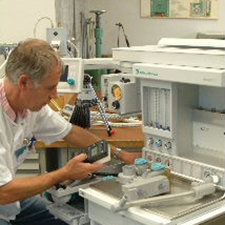
Yes, under certain conditions. It is not a problem if the work is such that no accidents requiring the assistance of another person are to be expected. If you work alone, you must be able to call for help by telephone or using another alarm. If you work alone for a longer period of time, it is advisable to inform a colleague, the doorman or a security guard in the event of an evening or night shift. They can then check regularly whether everything is going well.
Can I disinfect a worktop by spraying alcohol 70% on it?
No, spraying creates a fine mist and a the alcohol will evaporate rapidly. This can lead to the limit (maximum concentration of a substance in the individual breathing zone of a worker) being exceeded. In that case, there is a risk of harmful health effects or of the lower explosion limit being exceeded. Spreading the alcohol over the worktop with a damp cloth reduces this risk. Also, always be alert to sources of ignition when using alcohol.
Watch the video about spraying alcohol in the Good practices section.
A room once exploded due to spraying alcohol while the gas burner was still on. Spraying other substances may also lead to high concentrations in the ambient air. Spraying is therefore advised against wherever possible.
Can I store flammable substances in my workplace?
Yes, but only if you place them in a fire protection cabinet. A fire protection cabinet has a fire retardant effect and is therefore suitable for storing flammable substances.
Can I add water to a concentrate?
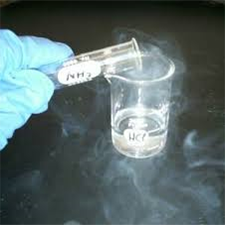
Or is it better to add the concentrate to the water? Well-known mnemonics are: 'Always do things as you oughta, add the acid to the water' and 'If you think your life's too placid, add the water to the acid’.
A dangerous substance with a strong acid character must always be added to sufficient water, never the other way around.
It is wise to apply the rule to other dangerous substances as well. Provide sufficient water and add the concentrate in small quantities at a time.
Can I clean with a strong cleaner and then with chlorine?
Yes, but after cleaning with one product, you should rinse with plenty of water before cleaning with the other.
You can also do it the other way around: first with chlorine and then with a powerful cleaner. But again, rinse with plenty of water before applying the other product.
Can I mix cleaning products?
No, it is not a good idea to mix cleaning products. Business processes use concentrated and powerful products of which not all components are always known. Mixing different products can lead to highly undesirable reactions.
Where can I find information about personal protective equipment?
The material safety data sheet (MSDS) of a product provides information about personal protective equipment. If it is unclear which means of protection you should use, please contact your OHS service. This information can also be found in the local registration system for dangerous substances and the linked NFU dangerous substances database. You are also obliged to wear personal protective equipment if this is prescribed because of the risks.
Must I wear personal protective equipment when using cleaners?
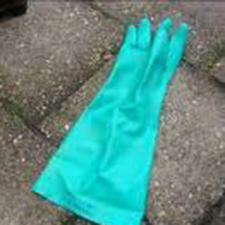
Yes, because washing machines in the UMCs are cleaned using concentrated cleaners. The concentrated products consist of acid and lye. If you need to transfer cleaners or connect drums, wear glasses and suitable gloves.
Am I obliged to wear Personal Protective Equipment?
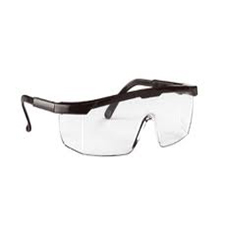
Yes, you are obliged to wear personal protective equipment if there are any risks associated with certain operations that require the wearing of Personal Protective Equipment (PPE). The employer is required to purchase the appropriate PPE and provide information about its use.
If I wear normal spectacles, do I also need to put on safety goggles?
No, not always. A normal pair of glasses with a sufficiently large surface area – possibly supplemented by protective caps on the sides – suffices for simple manual work. However, equipment containing pressurised fluid can squirt dangerous substances in your face with more force and volume, and therefore require the use of special safety goggles. There are special glasses available that can be worn over regular glasses. Sometimes safety goggles with prescription lenses can be provided.
Am I obliged to wear PPE when filling smaller containers?
Yes, use at least a pair of glasses or a face mask and suitable gloves. Depending on the type of dangerous substance, a suitable (plastic) apron and suitable footwear are important. For large quantities, respiratory protection must even be used and earthing must be provided to prevent static discharge. Moreover, you may only fill large quantities in an area that is suitable and equipped for this purpose.
Can I use the same gloves for all dangerous substances?
No, not always. There are many types of gloves. The type of glove to be used depends on the work involved and the type of dangerous substance.
In a care unit, disposable gloves (powder-free / latex-free or low-latex) can be used as protection against exposure to dangerous substances). See photo. The properties of the dangerous substance determine the choice of the type of disposable glove.
Short-term work
Disposable gloves provide protection against chemical exposure during short-term work. If they are made of nitrile, they are well-resistant to reasonably resistant to most chemicals and do not induce any latex allergy. A disposable glove must always be replaced and discarded immediately after contact.
Long-term work
For work involving prolonged exposure of the hands to dangerous substances, special safety gloves resistant to the chemical should be used. For example, there are gloves designed for working with strong and less strong acids, lyes, dry ice, liquid nitrogen, blood products and even oils and greases. These special heavy-duty gloves can be reused after cleaning.
NB Glasses, heavy aprons, face masks and respiratory protection can also be reused after cleaning. Half-face masks or canister filters, on the other hand, can only be used once.
Should there be a warning sign on the door of our lab?
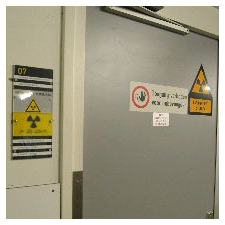
The local hospital policy applies. Most laboratories in hospitals are not chemical laboratories where large quantities of flammable or toxic substances are used. In any case, the storage area of these dangerous substances in the laboratory must be properly marked with a warning sign.
A fire protection cabinet must have a flame pictogram. The specific laboratories, such as a radionuclide, GMO ML-II or ML-III and microbiological laboratory where category 2 and 3 biological agents are cultured, must in any case have the appropriate warning signs on the entrance door.
Can I leave my dangerous substances in the fume cupboard?
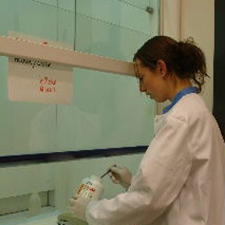
No, usually not. A fume cupboard is not a storage place for dangerous substances. By placing objects in the fume cupboard, the airflow can change in such a way as to neutralise the protective action of a fume cupboard.
If you use a few dangerous substances daily in a fume cupboard, you can leave this limited working stock in the fume cupboard of the laboratory. However, you must weigh the risk between bringing the bottles back and forth to the safety cabinet on a daily basis and leaving them in the fume cupboard.
If the safety cabinet is located in the immediate vicinity, you may decide to store the bottles in it. Prevent the airflow over the fume cupboard worktop being blocked by material placed in the fume cupboard. Place bottles on a bench or a stand that allows the air to flow through.
Can I store 1 M NaOH and 1 M HCl next to each other at the pH meter?
Yes, acids and lyes must be placed separately in drip trays only for stock storage. It is advisable to place unstable volumetric flasks in a receptacle to prevent them from falling over and leaking.
Can I to see whether a fume cupboard is working properly?
Yes, fume cupboards usually have an indicator light showing whether the fume extractor is working. Therefore, make sure that a broken laboratory fume cupboard light is replaced immediately.
Sometimes cabinets are fitted with an underpressure gauge. A small banner placed at the rear flow partition or a tissue at the window opening can indicate whether the cupboard is still working.
If the cupboard is overfilled (e.g. with waste containers), this can have a significant effect on its operation. You can check whether the cabinet still works properly by means of airflow measurements in the window opening in various places or by means of smoke tests. If serious doubts remain as to the proper functioning of the system, a professional measurement can provide the answer.
Can I work alone in the lab?
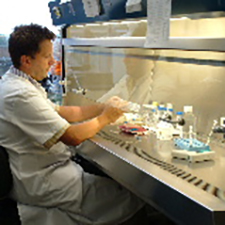
Yes, under certain conditions. It is not a problem if the work is such that an accident requiring immediate assistance from another person is not to be expected. If you work alone, you must be able to call for help by telephone or using another alarm.
If you work alone for a long period of time, it is advisable to inform your colleague or, during an evening or night shift, the doorman or security. They can then check regularly whether everything is going well. Do not work in a cold store if it does not have a time protection alarm.
If an alarm is present, there must be a colleague who can respond to the alarm.
There may be personal circumstances that make it unwise to work alone for a long time, such as a diabetic who may become unwell due to hypoglycaemia.
Can I request an occupational health examination myself?
Yes, a PME (preventive medical examination) is normally offered to you when you first start working with dangerous substances and if the risk assessment has shown that you will also be exposed to these health damaging substances (such as analysts who work with TB cultures). You can also apply for a PME if you or your colleague have a condition that could be the result of working with dangerous substances.
Is an occupational health examination always useful?
No, in the case of dangerous substances, this is not always the case.
There are some criteria for carrying out a health examination. This means that it is sometimes not useful to have one carried out, for example in the event of:
Specificity
A medical examination that is specific to the risk in question and has a predictive value must be available.
Relevance
The results of the research must be relevant and lead to consequences.
Alternatives
If there are other or better means of achieving the same objective, these should be used.
Proportionality
The material and immaterial costs for the employee and the company must be in reasonable proportion to the intended purpose.
Is the entrance door to a lab allowed to be left open?
No, in principle is not. In laboratories, the air management is set so that air in the room is changed several times per hour. The pressure in the laboratory is lower than that in the corridor. If the door remains open, the underpressure disappears and vapours and smells spread from the lab to the surrounding corridors.
Short-circuiting of air flows also affects the ventilation of the laboratory space. Doors also form part of the fire resistance of a room and must therefore remain closed. It is forbidden to leave the doors of radionuclide and GMO laboratories open.
Does the limit determine whether working with a substance is hazardous?
Yes, but only in part. The statutory limit and the administrative limit of a solvent indicate which concentration is still permitted or accepted. A substance with a low limit, such as chloroform (5 mg/m3 ), is more hazardous than ethanol (1000 mg/m3).
Whether or not the limit is reached during work depends very much on the degree of evaporation of the solvent. In addition to the type of action, the vapour pressure (P) is a determining factor. Working with ether (with a P of 587 mbar) will cause the limit (308 mg/m3) to be exceeded much more readily than working with xylene with a P of 8 mbar, although this has a lower limit (210 mg/m3).
The P/limit ratio, the relative inhalation risk, is a good parameter for comparing the risks of solvents. It is important to realise that the largest concentrations of solvent are generated in the air, especially when pouring solvents into another receptacle. Please note that the limit does not take fire risk into account.
The abbreviation MAC value is no longer used; the term limit has been introduced for this.
Are dangerous substances allowed to evaporate in the fume cupboard?
No, residues of chloroform, phenol or alcohol, for example, are often placed in a fume cupboard to evaporate. However, dangerous substances must be disposed of as such.
Discharges or emissions into the environment should be avoided as much as possible. Deliberately evaporating or flushing solvents if there are alternative disposal options is therefore not permitted.
Can I transport liquid nitrogen in a passenger lift?
Yes, if you abide by the following rules:
- Do not carry large amounts of liquid nitrogen in a lift with people in it.
As a general rule, quantities of less than 1 litre are permitted. - Transport the container in a stable condition.
- Transport a large amount of nitrogen with 2 people: the first person operates the lift externally with a key switch and the second person waits for the lift with the nitrogen container to arrive on the destination floor. People are not allowed in the lift.
